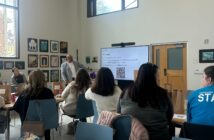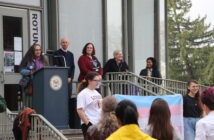
Elliott Nasby
Frank S. Beale was the squirrel whisperer.
They’re drawn toward the foot of the elderly man’s trousers. Having left his lecture minutes before, white chalk still clung to his fingertips. Light bent through the trees. He was indeed exalted by the squirrel kingdom as their benevolent master. In one hand he held a brown paper bag, the other outstretched as a fountain of assorted nuts fell from his fingers, with a long smile crawling across his face.
Beale was an assistant professor of mathematics at Lehigh in 1942, and he was nuts for much more than numbers.
When he wasn’t teaching class or marking exams, he was out feeding Lehigh’s squirrel population. He claimed to have tamed it, and perhaps he named his favorites. He distinguished them based on their markings and habits. One of these furry friends even allowed the occasional petting by Beale.
I don’t think of him as crazy, though. He put a valuable lesson on display, which was the importance of engaging with our natural world.
We’re lucky to be on a campus like Lehigh’s, whose upper levels are, in fact, considered a nature preserve for deer, birds, raccoons, chipmunks and squirrels. Moreover, the university implemented policies to protect it and see nature’s value.
Taken straight from our university website, “The environment in which the young adult university student pursues knowledge can make the total educational experience more meaningful, and that the ideal environment is separate and unique from the distractions of the nonacademic community.”
Fast forward long after Beale’s squirrel-taming days, and it seems the squirrels have persisted in hefty proportions. Coming from Florida, I’d never seen them get so large, so plump.
They’ve made South Mountain and the heart of campus their home just as much as we have. Maybe to you they’re a nuisance, a neighbor or just part of the backdrop. However, the critters, the trees, flowers and weeds make up an entire ecosystem managing to coexist alongside the bustling development of our university’s campus.
Author Nathaniel Johnson uses the term “unseen city,” which is the title of his most recent book — a guide to understanding the urban wilderness. He describes it as a phenomenon of constantly overlooking the wildlife that exists within our built environment. Beyond understanding, the book helps classify various species of trees, birds, snails and weeds common in cities and how to appreciate them. Apparently, several of these weeds are edible, even tasty to consume.
“We tend to value nature only when it’s distant and picturesque, and this causes huge problems. It makes nature an abstract perfection,” Johnson writes. “If we can learn to see and live with nature in our cities, it can add tremendous value to our lives.”
Creatures of the urban landscape are seldom admired for their resourcefulness, though they thrive in a seemingly unnatural environment. At Lehigh, most notably, we have those squirrels, deer and various bird species that enrich campus every day.
Arguably, the Lehigh squirrels have endured because of, rather than in spite of, the university. Close proximity to humans may deter predators or provide a dependable, constant source of food. However, most aren’t so lucky as to be hand-fed like Beale’s companions. Nevertheless, in extreme temperatures, hot or cold, they escape to building crevices and oak hollows on campus, and trash bins are probably somewhat of a ceaseless feast for them.
Sometimes merely knowing what something is called makes you appreciate it more.
“Synanthrope” classifies these organisms that live together with humans, and in some cases benefit from doing so. Evolutionarily speaking, proving useful to humans has been an advantage for some species. The ginkgo tree, for example, would’ve gone extinct if it hadn’t found itself to be an attractively useful piece in the urban landscape. Pigeons, too, yet now they might seem only a nuisance.
But understand the reason certain species of plants and animals continue to live in cities at all is because we selected them to in the first place. We choose which parts of nature go where. Starting with this knowledge, we can begin to feel compassion or, at the very least, appreciation.
Beale certainly indulged in his observant hobby, but there was some wisdom in it — taking the time to plop down on a bench and observe one’s surroundings. It’s calming and beneficial, being attuned to the crisp evening air, the banter of an early-rising robin or the snap of a twig under the hoof of a deer.
—
Elliott Nasby, ’20, is an assistant sports editor for The Brown and White. He can be reached at ebn220@lehigh.edu.





Comment policy
Comments posted to The Brown and White website are reviewed by a moderator before being approved. Incendiary speech or harassing language, including comments targeted at individuals, may be deemed unacceptable and not published. Spam and other soliciting will also be declined.
The Brown and White also reserves the right to not publish entirely anonymous comments.
1 Comment
Lehigh’s resident red tail hawks, Engi and Neer, are very appreciative of the existence of well fed squirrels on the campus. It seemed as though the main meal for the three young hawks last year was squirrel. Supposedly the main food for these hawks is smaller animals. There may be a lack of mice and rats on campus or it may be that squirrels give them more bang for the buck.